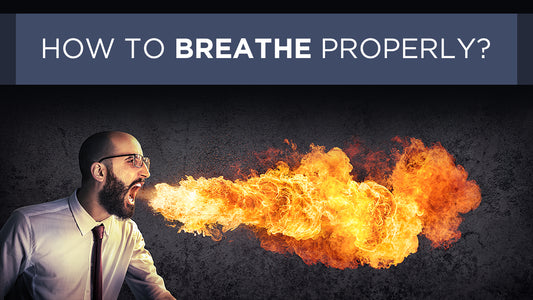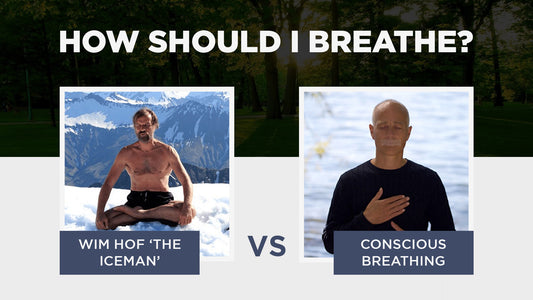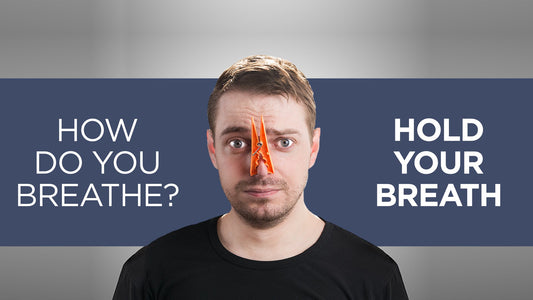
Pilot study – nasal vs. mouth breathing
During the spring of 2011 a pilot study of nasal vs. mouth breathing was conducted on ten individuals that performed breathing exercises for a period of three weeks (or more). The exercise involved participating in physical activities with their mouths closed at least three times a week, for 30 minutes, in addition to practicing with the Relaxator Breath Trainer.
Afterwards each participant in the study took two separate maximum oxygen uptake ability test (VO2 max test) while bicycling, once while mouth breathing, and once while nasal breathing.
The purpose of the study was to research whether the body reacts differently to physical activity when using nasal breathing instead of mouth breathing.
Compilation of interesting results
- Nasal breathing reduced lactic acid by 11 percent (8.0 mmol/L), compared to mouth breathing (9.0 mmol/L).
- Participants took 22 percent fewer breaths when nasal breathing (31) compared to mouth breathing (40).
- Four out of ten subjects were able to bike with greater intensity when nasal breathing compared to mouth breathing.
- Former Swedish triathlon record-holder (2005-2012) Clas Björling had 38% less lactic acid (295 Watts load) when using nasal breathing, 3.4 mmol/L, compared to 5.5 mmol/L during mouth breathing. Further Clas had 10% lower heart rate, at 295 Watts load, 139 with nasal breathing and 155 with mouth breathing.
- Anna Bjurstam had 34% less lactic acid when she was breathing through her nose.
- Anette Einarsson took 31% fewer breaths during nasal breathing.
- Mattias Andersson, a former Nordic champion in Tae-Kwondo and an asthmatic, took 26% fewer breaths during nasal breathing. Mattias had an asthma attack after the test where he biked and only breathed through his mouth and had to take bricanyl. However, after biking using nasal breathing, not only was he able to push back a looming asthma attack, he also managed to cycle for two minutes and fifteen seconds longer.
- Daniel Bäck was able to bike for 4 minutes longer (at higher load) during nasal breathing compared to mouth breathing.
Conclusion
While there is a potential for error, due to measuring equipment, or habituation, for example, the reduced amounts of lactic acid produced when using nasal breathing do point to an increase in stamina. Fewer breaths taken using nasal breathing is another important factor, since each breath requires energy (3-5% of the body’s resources at rest), so there is more energy left over.
The most important result is the fact that all the participants agreed that they will continue using nasal breathing as much as possible, both in their daily lives, as well as when exercising because it feels more natural.
Many also view nasal breathing as an excellent tool for finding peace and keeping stress at bay. Carrying out the study has been an enriching experience, both for me and the participants’, and it would be great if it inspired others to undertake further research on the subject.
Participants’ comments

Clas Björling, triathlete, personal coach, lecturer, and former Swedish record holder of the triathlon IronMan-distance (2005-2012), with a time of eight hours and fifteen minutes.
Breathing study: “My legs felt stronger during nasal breathing; I would probably have managed a higher load than when using mouth breathing if I hadn’t developed a headache. The feeling of harmony afterwards was really pleasant!”
Nasal breathing during exercise: “In general, I think it is still a bit tricky when I get up to higher levels of exertion, but I’m going to stick with it as I really believe in it.” * Six months after the study Clas had raised his maximum heart rate with nasal breathing from 139 to 162, which is close to his maximum heart rate of 178.
Conscious Breathing: “I feel like I have a tool to use in keeping my calm when I’m up against any kind of stress. Even when I’m sitting in front of the computer working, I can slowly get stressed out, but when that happens, I stick the Relaxator in my mouth and regain my calm and control.”
The Relaxator: “The Relaxator feels great, I always have it around my neck and use it whenever I get in the car or on the train, or when I work at the computer. This often adds up to several hours a day.”
---------------------------------------------------------------------------------------------------------------------------------------------------------

Ulf Dextegen, hypnosis instructor, free diver holder of two World Championship Bronze medals (Ulf is able to hold his breath for nine minutes)
Breathing study: “I get a feeling of flow that is more rhythmical when using nasal breathing. It feels less mentally arduous.”
Nasal breathing during exercise: “It can be really tough to use nasal breathing when I’m running hard, but at the same time I get a feeling of flow and recover faster. Personally, I found nasal breathing useful when I got the Swedish Championship Gold medal in static apnea (holding your breath underwater for as long as possible without swimming), on March 25th, 2011. The nasal breathing didn’t just help me do away with competition nerves entirely, I was also able to fully relax every muscle in my body, even deep down inside, muscles we cannot normally control, as I lay in my bodysuit, floating on my back for fifteen minutes before I started the dive. Thanks to that comprehensive relaxation, my rate of oxygen use sank and I got into the flow much easier, even before I had started. I got to eight minutes and thirteen seconds, which was good enough for a Swedish gold and 2nd place in the 2011 world rankings (so far).”
Conscious Breathing: “I am now more conscious about breathing to relax in certain situations, where before I hadn’t even thought about it. For example, when in the tube or at meetings I will start using nasal breathing and, just like that, I’m more relaxed.”
The Relaxator: “The Relaxator is a resource that helps me wind down. It is only when running hard (uphill) that it is really difficult.”
---------------------------------------------------------------------------------------------------------------------------------------------------------

Anna Bjurstam, founder and manager Raison d’Etre Spas
Breathing study: “I managed 30 seconds at a higher intensity during nasal breathing and could have gone much longer. My legs felt fresh, but couldn’t go further because of a light feeling of panic – I had no room to clear my throat, etc. The fact I felt fresh is also due to the fact I had less lactic acid (34% less) when using nasal breathing.”
Nasal breathing during exercise: “It simply feels completely intuitive for the body and I will continue to train with my mouth closed.”
Conscious Breathing: “I think about breathing through my nose almost all the time.”
The Relaxator: “Using the Relaxator feels good because it helps me to relax. I think it is a really great tool.”
---------------------------------------------------------------------------------------------------------------------------------------------------------

Anette Einarsson, inspirational and health coach at Twinspiration AB
Breathing study: “My legs were stronger during nasal breathing, but I wasn’t able to cycle as long as with mouth breathing, which I found frustrating. My legs didn’t give out, it was more as if I couldn’t get enough air.”
Nasal breathing during exercise: “It feels good to breathe through my nose when exercising and I am convinced that it is better to exercise with your mouth closed. It gets arduous when the intensity is too high, but I am aware that it is just a question of training so that my body gets used to it.”
Conscious Breathing: “I can break the stress faster when it comes. Being conscious of your breathing is a good way to learn about yourself in different situations."
The Relaxator: “Using the Relaxator feels very good. I will use it, for the rest of my life.”
---------------------------------------------------------------------------------------------------------------------------------------------------------

Mattias Andersson, former Nordic Tae-Kwondo Champion and asthmatic
Breathing study: “I feel more relaxed after the nasal breathing. I got a strong asthma attack for 10 minutes after the mouth breathing and had to take bricanyl, but when I used nasal breathing, I was able to press back the attack with the help of abdominal breathing, too.”
Nasal breathing during exercise: “My breathing becomes calmer and more even, and my mouth gets less dry. I also suffer less from asthma.”
Conscious Breathing: “I breathe consciously almost throughout the day. I am so thankful that you opened my eyes to conscious breathing. If it weren’t for you, there is no way I would feel as good as I do, now. I can’t describe the feeling of being able to breathe, of not suffering from shortness of breath and having to take medicine anymore. Healthy people think about all sorts of things, but ill people only think about feeling healthy again. I have been given back my happiness, and now my thoughts are occupied with planning for the future and appreciating the moment. I am forever in your debt! In a way, you have saved my life.”
The Relaxator: “I use the Relaxator for about half an hour a day. It feels as if my lungs are expanding. When I have an asthma attack, I can get it under control by using the Relaxator.”
---------------------------------------------------------------------------------------------------------------------------------------------------------

Daniel Bäck, golf instructor, the Daniel Bäck Golf Academy
Breathing study: “It felt easier to exert myself when breathing through my nose. Using nasal breathing, I managed to bike four minutes at a higher intensity.”
Nasal breathing during exercise: “It feels really good! I will continue exercising with a closed mouth and will recommend it to everyone I know.”
Conscious Breathing: “I have become more aware of my breathing when I’m at the computer, for example. With the Relaxator in my mouth, I became aware that my breathing has a tendency to stop.”
The Relaxator: “Exhalation is the main thing for me. Using the Relaxator, I feel relaxed and really get in touch with my lower abdominal muscles.”
---------------------------------------------------------------------------------------------------------------------------------------------------------

Christel Dopping, health journalist, coach and author
Breathing study: “I didn’t get at all as sweaty breathing through my nose. I was able to wind down quicker. I didn’t get a dry mouth.”
Nasal breathing during exercise: “It feels like it does when I meditate. I feel more centered, more focused. It’s difficult when I’m playing tennis, but easier when walking and cross training.”
Conscious Breathing: “It makes me feel more centered, more focused and gives me the sensation that I am conserving my energy. It helps me find calm and keep stress at bay.”
The Relaxator: “Using the Relaxator feels absolutely fine.”
---------------------------------------------------------------------------------------------------------------------------------------------------------

Anna-Maria Broberg, Feldenkreis teacher, coach and business consultant at SomaticMind.
Breathing study: “I got a dry throat and felt thirsty when I used mouth breathing, which didn’t happen when I used nasal breathing.”
Nasal breathing during exercise: “A big difference. It feels like my arms and legs are able to do more when I’m using nasal breathing, because the focus is more on my back/abdomen where the real strength is, biomechanically speaking.”
Conscious Breathing: “Being aware of my breathing gives me a super ability to be in the moment.”
The Relaxator: “I use the Relaxator for meditation, among other things, which feels great.”





